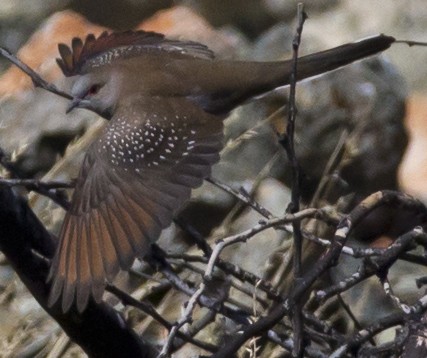Diamond Dove
A species of Australasian Ground Doves Scientific name : Geopelia cuneata Genus : Australasian Ground Doves
Diamond Dove, A species of Australasian Ground Doves
Botanical name: Geopelia cuneata
Genus: Australasian Ground Doves
Content
Description People often ask General Info
 Photo By Jim Bendon , used under CC-BY-SA-2.0 /Cropped and compressed from original
Photo By Jim Bendon , used under CC-BY-SA-2.0 /Cropped and compressed from original Description
They are small pigeons with a length of 19 to 21 centimetres or 9 to 11 inches. Regardless of sex, they have white spots and black edges on their wings, red eyes and orange eye-rings. The sexes look similar except the female's eye ring is less vivid and has more of a brown colour to the plumage. The male's head, neck, and breast are light blue-grey. The bill is a dark grey colour. The abdomen is a creamy colour while the back and tail is a brown-grey colour. The legs and feet are pink. The juveniles have a light grey bill; the iris and eye ring is fawn in colour; the feet and legs are grey; the breast is grey and does not possess any white spots on their wings. 
Size
24 cm
Colors
Brown
Black
Gray
White
Blue
Orange
Life Expectancy
10 years
Nest Placement
Tree
Feeding Habits
Diamond Dove mainly consume grass seeds and occasionally supplement their diet with ants. They typically forage on the ground, showcasing a preference for seeds as a primary food source.
Habitat
Diamond Dove favor habitats that are lightly wooded, typically in arid or semi-arid grasslands, with consistent availability of water. These birds are predominantly located in broader geographical regions with semi-arid climates, often frequenting areas adjacent to roads and pathways. Their ability to adapt has allowed them to inhabit parks and gardens within more temperate zones during particularly dry spells in their usual habitats.
Dite type
Granivorous
People often ask
General Info
Feeding Habits
Bird food type
Behavior
The diamond dove is often seen on the ground, where it runs with a waddling gait. Its flight is strong, direct, and sometimes undulating. The wings can make a whistling "frrr" noise when flying. Diamond doves tend to be seen in pairs or small groups feeding off the ground. They feed off seed mostly from grasses. They will also eat ants. The doves tend to breed after rain but mostly in spring in Southern Australia. Nests are usually built from interwoven grasses and/or twigs, and are fragile in construction. Two white eggs are usually laid and incubated for 13 to 14 days. Their chicks are fast to grow, and are usually fully feathered and flying by two weeks. They are known to have a variety of calls. The calls sound mournful, slow and have a soft, pleasant falsetto quality to them. Two calls consist of two long coos followed by a pause and then a long, short and long coo. Sometimes they call two long coos. The alarm coo consists of a few short but loud coos. 
Species Status
Not globally threatened.